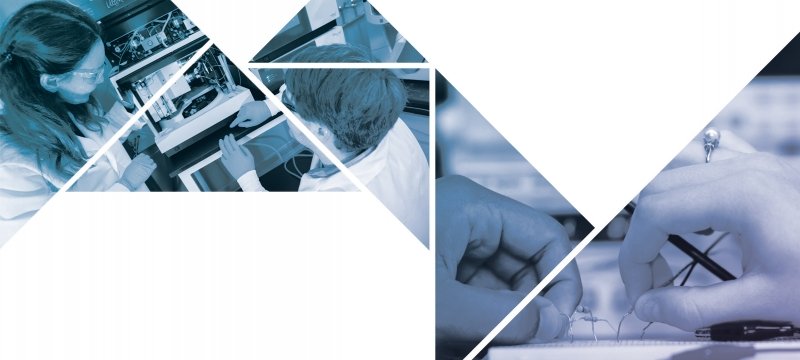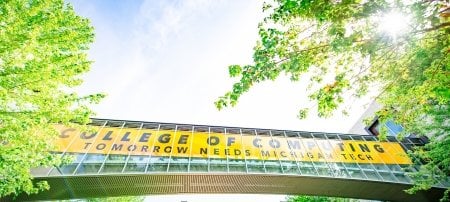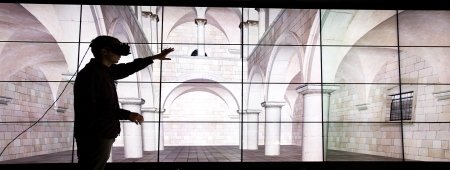Computing is the fastest-growing sector across all industries. The National Science Foundation estimated that science and engineering jobs increased by 18.7 percent over the past decade, and 59 percent of that growth was in computing. This upward trend continues. We have a plan for this future: Say hello to the new College of Computing.
When the Association for Computing Machinery (ACM) dug into the 2016 US Bureau of Labor Statistics data, they found that 76 percent of new STEM jobs—careers that didn't exist previously—are in computing. Each year, most new jobs in STEM fields peak around 4,000 new positions. In computing, there are more than 20,000 new jobs opening each year in software development, systems analysis, computing support, and network administration.
Many companies, from Ford to Plexus to Google Cloud, have told Michigan Tech recruiters that computing skills are at the top of their list. With overall job placement rates above 90 percent in nearly all disciplines at MTU—specifically 92 percent in computer science—responding to industry demand means thinking forward to students' future jobs and the preparation those students need now.
"Technological is our middle name," says Adrienne Minerick '98, dean of the College of Computing and professor of chemical engineering, adding that a name is a core identity, not an end product. "The national data reveals how much the T in STEM now means computing, and computing skills bridge all STEM fields."

To connect today's students to tomorrow's jobs, the College of Computing builds on what we already do well: teach students solid programming and data management skills, execute innovative interdisciplinary research, and run outreach programs to boost K-12 computer science literacy. The first of its kind in Michigan, the College opens up new opportunities like degree programs, specialties in health informatics and cybersecurity, and entrepreneurship—and does so by drawing on the University's existing strengths. From collaborating with the new Institute for Policy, Ethics, and Culture to connecting students to real-world problems through the Enterprise program, senior design, and undergraduate research experiences, the College does not shirk the social challenges that tomorrow's coders, inventors, artificial intelligence (AI) developers, data managers, and artists will face.
"Michigan Tech has always been a university where teaching informs research and innovation, and simultaneously where advanced research enriches students' education," says Tim Havens '99 '00, director of the College's research arm, the Institute of Computing and Cybersystems (ICC), and the William and Gloria Jackson Associate Professor of Computer Systems. "From first-year to PhDs, all of our students are rolling up their sleeves and solving hard problems: They collaborate across degree boundaries in an Enterprise that builds self-driving cars, or new pathways in a large interdisciplinary research project on early detection of Alzheimer's using AI. These are the types of experiences that make Michigan Tech students so sought after by employers."

My Michigan Tech: Hunter Higdon
Hunter Higdon, an undergraduate computer science major, talks about why he chose computer science and Michigan Tech. The short answer? He's felt part of a community since day one, thanks to caring professors and classmates.
"Compared to other colleges, the CS community here is outstanding—like we have our own [dorm] hall for CS people and that's where I lived my first year of school."
Minerick and Havens agree: Teaching and research in computing are soldered on the same circuit board. And the connections are many. The College of Computing actively collaborates with 18 other colleges and departments; the ICC's five research centers house 50 members from 15 different academic units to tackle cybersecurity, data sciences, cyber- physical systems, scalable architectures and systems, and human-centered computing. In other words, whether it's healthcare data, virtual reality tech, corporate IT, or climate change modeling, almost every modern system has a computing aspect.
The College offers five undergraduate degrees, four graduate degrees, and the vision is to establish programs that enable every Michigan Tech student to learn the computing skills needed for their dream job regardless of their major. The team has termed these convergence programs; they're not a double-major but a hybrid program at the intersection of disciplines. So, if a mechanical engineering student wants to specialize in robotics, she needs Python programming courses; if a sound designer wants to push music to the limits, understanding acoustic digitization helps him; if a biomedical engineering and pre-med double major wants to improve telesurgery practices, they need to know the principles of human-computer interface design and wireless networking.
Degrees and Research
Research Areas
- Artificial Intelligence and Machine Learning
- Cyber-Physical Systems
- Cybersecurity
- Data Sciences
- Education, Society, and Profession
- Human-Centered Computing
- Programming Languages and Software Engineering
- Scalable Architectures and Systems
- Security and Privacy
- Systems and Networking
Degrees Offered
"We pride ourselves at setting our first-year students up to succeed and at preparing our graduates to hit the ground running," Minerick says. To do that, Havens says the College has to work with the reality that computing is ubiquitous: "Nearly all innovations are computational. Computers and the language of computing are essential tools for STEM graduates."
Also, the College of Computing faculty recognize that first exposure in an introductory computer science course can be intimidating. So within the computer science degree there are initially two tracks; one that assumes the first line of code a student writes is in class here on campus and a second track that builds on previous coding knowledge. By the end of year two, both tracks converge to the same classes and challenges.
To help bridge the gap before students reach college, faculty partner with K-12 schools to enhance digital literacy to pique student's interests and increase confidence: Afterschool outreach, summer camps, teacher training, and coding events are all part of the ecosystem. Professors Yu Cai and Guy Hembroff '98 '16 teamed up with the local school district with funding from the National Security Agency and National Science Foundation to put together the GENcyber camp for high school students and their teachers, as well as a career tech education course on cybersecurity. Emily Gochis, director of the local MiSTEM Network office, works alongside Copper Country Intermediate School District Superintendent George Stockero and educational technologist Steve Cass.
"We want to open the eyes for students and their teachers, and create opportunities for students that might not traditionally have access to these programs," Cass says, which Stockero echoes: "We want to get kids excited, inspire them to go to a place like Tech, then hire them back in our community.
"Whether students choose to stay in the Keweenaw or pursue careers around the globe, the career alignment and pathways that the College and its collaborators foresee are versatile. The challenges, opportunities, and surprises of spaces where digital meets physical are too numerous and enticing to be fixed on a neat conveyor belt. The assembly- line age of converting students into professionals for the workforce is ending. Instead, the drive of this multi-limbed, semi-autonomous educational machine is fueled by self- authorship, customization, excitement, curiosity, and the strong desire to make a positive difference. A programmer's journey may start with the language basics of the ("Hello,World!") program, but the journey rapidly progresses to real conversations and implementation grounded in a balanced code of ethics, social justice, and resource consciousness. The College of Computing is where they begin.
-
92%CS job placement
-
1:5jobs are STEM-related in Michigan (State of Michigan Bureau of Labor Market and Strategic Initiative)
-
18.2%computing job growth rate 2010-20 (National Science Foundation)
-
76%of new jobs in STEM fields are in computing through 2024 (US Bureau of Labor Statistics, Association for Computing Machinery)
Convergence
Convergence brings the far-reaching influence of computing back to a core set of research and teaching values. The work redefines the digital interfaces of classrooms, labs, citizen and scientist, manual labor, and automagical processes. The examples are many. Here are a few plugged into the College of Computing.

Coders Create a Virtual Future
Careers require coding skills and even the offices themselves will be as virtual as they are physical. That matters because voice recognition and virtual reality interfaces can help make everyday tasks more productive and accessible.
Drive Autonomous and Connected Vehicles
The Prometheus Borealis student team streamlines and vets their AutoDrive Challenge competition car in the same space as industry prototypes, military test vehicles, and farm equipment in the Advanced Power Systems (APS) LABS and on the Keweenaw Research Center's test tracks. Something most vehicles in the shop have in common: Fixing them up, tweaking designs, and making them road-ready is no longer done simply by popping the hood. Of course, there is no replacing a good mechanic and handling the intricacies of today's vehicles through models, sensors, and simulations requires a lot of digital elbow grease. To get an autonomous vehicle rolling requires a span of disciplines—mechanical and electrical engineering, human factors, remote sensing—and computing is what gets each part to talk to each other.
Read more about mobility at Michigan Tech.
"We are thrilled to bring the Google Cloud Hero experience to Michigan Tech, and look forward to connecting with students to help them explore career opportunities in today's technologically advanced world."
Protect Healthcare and Power Grids
What do energy systems and patient records have in common? Lots and lots of data.
Both are also vulnerable. Cyberattacks can greatly affect energy and health systems and the current technologies they rely on are not up to code, so to speak. While protection and privacy are a big part of the challenge, efficiency and accuracy are also important. Laura Brown, associate professor of computer science, studies how to streamline electricity generation, distribution, and use—and how to help the rapidly evolving grid handle distributed generation from renewables and other sources. Guy Hembroff, associate professor of health informatics, focuses on streamlining healthcare systems.

Health Informatics
Medical or health informatics focuses on information technology to positively impact the patient - physician relationship through effective collection, safeguarding, and understanding of health data.
"While there are many challenges associated with rural healthcare delivery, there is a dedicated passion from medical practitioners to improve care delivery and decrease the expense of healthcare in their community," Hembroff says. "If technology is done right, it can help support this passion by overcoming many of the barriers of rural healthcare."
Sustain Performance, Efficiency, and Privacy
Computers and data storage have changed a lot since Sony released the first floppy disk in 1981. As computers and processors have shrunk in size and maximized power, businesses and consumers race to keep up. What has lagged behind, however, is not creating the latest and greatest version but rather improving what's already at hand.
Data management and thoughtful networking is as much art as science in the sense that anyone can write a line of sloppy code like it's finger painting but keeping a program tidy is more than coloring inside the lines. Clean, efficient code affects how much juice a program needs to run, which affects how much electricity the processor demands, which affects the bottom line and environmental footprint of seemingly invisible digital work.
Professor Yu Cai and others work to enhance this efficiency through green computing while others like Bo Chen, assistant professor of computer science, do so by thinking about black hats. That is, more streamlined ways to beat hackers.
"Malware is more and more difficult to detect and analyze," Chen says. "Likewise, our techniques need to be intelligent, too."
Map History
Much of the hard work of computing happens behind-the-scenes. But occasionally some projects highlight the beauty of a digital interface. One such example is the Keweenaw Time Traveler.
A collaborative project between computer scientists, historians, geographers, and social scientists, the Keweenaw Time Traveler brings history to the fingertips of local residents and visitors. Using the principles of deep mapping—an understanding of a place through pinpointing culture and stories over time—the National Science Foundation-funded project is brought to life through an online portal where people can look up the history and old maps of a home, business, street, or town.
Reach Out and Introduce
Formal and informal classrooms help students see the whole style sheet for a line of code (a digital way of saying the forest for the trees).
In the community, lecturer and CS learning center coordinator Leo Ureel '95 '03 teams up with enthusiastic undergrads, inspired grad students, and eager K-12 students to pull together coding events like Code Ninjas and maintain groups like the Copper Country Coders.
In first-year courses, professors like Linda Ott build up student skills and interests: "I match up each of my nearly 200 students in CS1000 with department alumni to learn about their careers. Each student writes a report where they show how surprised and excited they are about the diversity of places alums work, from the giants like Amazon, Microsoft, and Google, to small start-ups in all types of industries, to government agencies. That goes for the wide variety of jobs they hold—from software developer to president—and the variety of industries from the auto industry to telecommunications."
And "student" is not defined by age. In a collaboration between CS and the Department of Cognitive and Learning Sciences, researchers Chuck Wallace and Kelly Steelman work with a team of students to help teach older adults on Saturday mornings at the Portage Lake Public Library. Digital literacy is a challenge across ages. Each group and setting requires the kind of tailored and thoughtful approach built into the College of Computing curriculum and outreach.
Read more about our transdisciplinary researchers.
Start With a Handshake
When he couldn't find the internship he wanted, Garrett Lord decided to put his computer science skills from class to good use. He founded Handshake with two fellow Michigan Tech students, Scott Ringwelski and Ben Christensen.
Handshake is a career network and recruiting platform for students that seeks to level the playing field. As the company puts it, they're more than a job board, and a job search should work for you. Collaborating with 800 universities and 400,000 employer partners, Handshake has quickly become a competitive app for a competitive job market.
And the skills needed to pull off a bold business venture like Handshake come out of experiences in and out of the classroom. Computing extends a hand and shakes up the norm.
Michigan Technological University is an R1 public research university founded in 1885 in Houghton, and is home to nearly 7,500 students from more than 60 countries around the world. Consistently ranked among the best universities in the country for return on investment, Michigan's flagship technological university offers more than 120 undergraduate and graduate degree programs in science and technology, engineering, computing, forestry, business, health professions, humanities, mathematics, social sciences, and the arts. The rural campus is situated just miles from Lake Superior in Michigan's Upper Peninsula, offering year-round opportunities for outdoor adventure.






![Tech’s annual Computing [MTU] Showcase comes to campus Oct. 2-4.](http://www.mtu.edu/news/2024/09/images/cyber-security-202110070277-banner450.jpg)